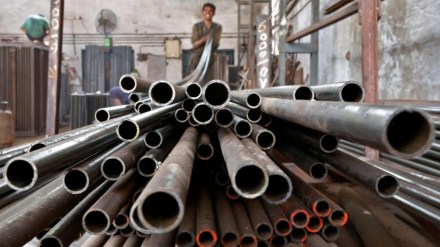The domestic steel industry, which accounts for 12% of the country’s CO2 emissions, is fast adopting scalable, future-oriented technologies to reduce its carbon footprint, but expects all stakeholders, as well as the government, to chip in and support their initiatives.
The industry, which contributes over 2% to the GDP, emits 2.55 total carbon dioxide content (TCO2) per tonne of crude steel (tcs), compared to the global average of 1.85 TCO2/tcs.
India produced 131 million tonnes (MT) of steel in 2023, recording a 12.6% y-oy growth.
In 2023, India produced 46% or around 60 MT crude steel through the CO2-emitting blast furnace (BF-BoF) route. Another 70 MT capacity addition through the BF-BoF route is in the pipeline.
India’s present steel-making capacity is around 164 MTPA, while the target is to enhance it to 300 MTPA by 2030-31.
All the leading producers recognise that de-carbonisation is an existential necessity and are working on improving their energy and resource efficiency by modifying their production process. They have set different target years to achieve their journey towards net zero in line with the government’s commitment.
“As a responsible corporate, it is essential for us not only to align with the country’s net-zero objectives, but also to be benchmarked with the global de-carbonisation standards. Our commitment to attaining net-zero steel-making drives our actions on energy efficiency, resource efficiency, mining, process modifications/improvements, etc. We are investing in scalable future technologies, in collaboration with top technology providers, academia and internal resources,” said Amarendu Prakash, chairman, SAIL.
TV Narendran, CEO and MD, Tata Steel, said, “Driving the demand for green steel in India would require a paradigm shift – a collective commitment from all stakeholders, manufacturers, policymakers and customers. It is about producing eco-friendly steel and fostering a conscious consumption culture.”
He said the key elements are industry commitment to planned capital investments, a supportive regulatory framework to incentivise green steel production and customers willing to pay an appropriate price.
Alok Sahay, secretary-general, Indian Steel Association, said, “Decarbonising the steel sector is critical and important towards saving the planet for future generations, apart from its economic implications.”
Narendran said, “While progress is underway, further policy development is crucial. Tata Steel is actively investing in sustainable practices, recognising the multifaceted challenge. We believe in a collaborative approach to enable a greener and more responsible steel ecosystem.”
Sahay said the task needs to be given ample focus and impetus by all stakeholders, including by the government and industry.
The Global North has a much more significant role to play.
The steel ministry has set phase-wise goals for decarbonising the sector.
In the short term, the focus is on reducing carbon emissions in the industry by promoting energy and resource efficiency and enhancing the use of renewable energy. It has constituted 13 task forces to look into various aspects of de-carbonisation of the steel sector. The task forces are developing a taxonomy, CO2 monitoring and measurement methods, green steel demand generation, material efficiency, green hydrogen, energy efficiency, renewable energy and CCSU (Carbon Capture, Utilisation and Storage).
